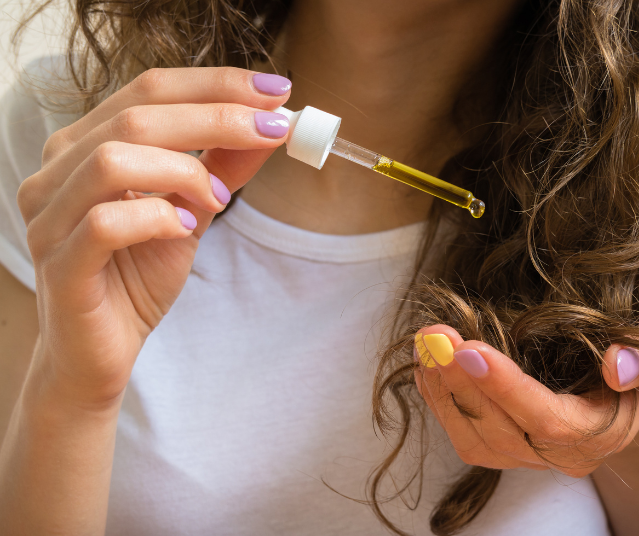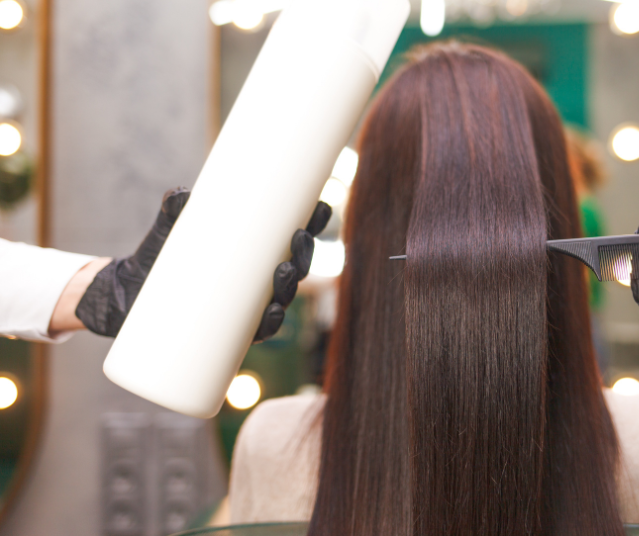Introduction
Damaged hair can be a source of frustration, affecting confidence and appearance. But you’re not alone; countless people struggle with hair damage caused by various factors like heat styling, chemicals, or lack of proper care. Fortunately, the journey from damaged hair to healthy hair is entirely achievable with the right approach and tools. This guide will provide you with everything you need to know on how to repair damaged hair, how to fix damaged hair, and tips to revive even heat-damaged hair.
1. What Causes Damaged Hair?

Understanding the Roots of Hair Damage: Causes and Solutions for “Damaged Hair”
Hair is one of the most defining features of our appearance, and for many, it serves as a symbol of health, vitality, and beauty. Healthy hair is shiny, smooth, and full of life, while damaged hair is often dull, brittle, and prone to breakage. Understanding the causes and roots of hair damage is crucial to preventing further harm and restoring your hair to its optimal state. In this article, we will explore the various factors that contribute to damaged hair, the impact these factors have on the hair structure, and effective methods for repairing and maintaining healthier hair.
Know More : Dandruff Hair
What Is Damaged Hair?
“Damaged hair” refers to hair that has been weakened, dried out, or altered due to internal or external factors. Healthy hair grows from the scalp in a protective structure known as the hair follicle. Each strand of hair consists of layers, with the outermost layer called the cuticle, which is made of overlapping cells that protect the inner layers of the hair. When hair becomes damaged, these protective layers can become frayed, broken, or stripped away, leaving the hair vulnerable to further stress.
The Roots of Hair Damage: Common Causes
Hair damage can occur due to a variety of reasons, many of which stem from external practices, environmental factors, and internal health issues. These can range from physical damage caused by styling tools to the effects of chemicals in hair products. Below, we explore the most common causes of damaged hair:
1. Heat Styling and Chemical Treatments
Heat styling tools like flat irons, curling irons, and blow dryers are some of the most common causes of hair damage. When heat is applied to the hair, it opens up the cuticle and causes moisture to evaporate, leading to dryness and brittleness. Prolonged exposure to high temperatures can cause the hair’s protein structure to break down, making it more fragile and prone to breakage.
Chemical treatments such as coloring, perming, and relaxing also weaken the hair structure. These treatments often involve harsh chemicals that break down the natural bonds in the hair, leading to a reduction in strength and elasticity. Over time, these chemical treatments can leave hair looking dull, fragile, and over-processed.
- Heat damage: Using high heat settings or applying heat too often without protective measures can strip the hair of moisture.
- Chemical damage: Repeated dyeing, bleaching, or perming can compromise the hair’s integrity and lead to irreversible damage.
2. Over-Washing and Harsh Shampoo Ingredients
Washing your hair too frequently or using harsh shampoos can strip your hair of its natural oils. Natural oils, or sebum, protect the hair, keeping it moisturized and healthy. When this oil is stripped away, hair can become dry and more susceptible to damage from environmental factors.
Many commercial shampoos contain sulfates and other strong detergents that, while effective at cleansing the hair, can be too aggressive for the scalp and hair, particularly for people with sensitive or dry hair. These chemicals can lead to an imbalance in the scalp, causing either excessive dryness or oil production, both of which contribute to hair damage.
- Sulfates: Common in many shampoos, sulfates are strong surfactants that can dry out the scalp and hair.
- Over-washing: Washing hair too often can lead to dryness and strip away the natural oils that protect the hair.
3. Environmental Factors
Exposure to the environment can also have a significant impact on hair health. For example, prolonged sun exposure can damage the hair’s protein structure, causing it to become dry, brittle, and more likely to break. Ultraviolet (UV) rays can also lighten hair color and create a rough, frizzy texture.
On the other hand, extreme weather conditions such as cold winds, snow, or dry air can strip moisture from hair, leading to dryness and static. Additionally, exposure to pollutants, chlorine in swimming pools, and salty sea air can also damage hair by breaking down its protective outer layer.
- UV damage: The sun’s rays can dry out and weaken hair fibers.
- Cold and dry air: These conditions rob hair of moisture, causing it to look frizzy and brittle.
- Chlorine: Swimming in chlorinated pools can lead to hair that feels dry and coarse.
4. Poor Nutrition and Health
The health of your hair is directly tied to your overall well-being, and poor nutrition can contribute significantly to hair damage. Hair is primarily made of keratin, a protein, so a lack of protein in your diet can cause hair to become weak, thin, and brittle. Deficiencies in essential vitamins and minerals, such as iron, vitamin D, biotin, and zinc, can also impair hair health and contribute to hair thinning or breakage.
Additionally, stress and hormonal imbalances can affect the hair growth cycle. Stress has been linked to hair loss conditions such as telogen effluvium, where hair prematurely enters the shedding phase, leading to thinning and increased hair loss.
- Poor diet: Lack of nutrients like protein, vitamins, and minerals can cause hair to become weak and prone to breakage.
- Stress: Stress can disrupt the natural hair growth cycle, leading to hair loss or shedding.
- Hormonal imbalances: Changes in hormones, such as those caused by pregnancy or thyroid disorders, can lead to hair thinning or loss.
5. Mechanical Damage from Styling and Handling
Hair can also become damaged from the way it is styled or handled on a daily basis. Rough brushing, tight hairstyles, or using hair accessories that pull on the strands can all cause mechanical damage to the hair shaft. For instance, pulling hair back into tight ponytails or braids can lead to traction alopecia, a form of hair loss caused by stress on the hair follicles.
Similarly, using coarse towels to dry hair or combing wet hair (when it is more prone to breakage) can lead to split ends and breakage. In general, excessive friction and tension on the hair contribute to the breakdown of the hair shaft and can weaken hair over time.
- Tight hairstyles: Styles like braids, ponytails, or buns can cause breakage or traction alopecia.
- Rough handling: Vigorous towel drying or combing wet hair can lead to mechanical damage and breakage.
- Excessive brushing: Brushing hair too often or with the wrong kind of brush can cause hair to break or split.
2. How to Recognize Damaged Hair
Signs Your Hair is Damaged and Needs Repair
Hair is often considered a reflection of overall health and well-being, and its appearance can offer important clues about how well it’s being cared for. Damaged hair is a common issue that affects many people, yet it can be challenging to pinpoint the damage, especially in its early stages. Whether you’re dealing with occasional breakage, excessive frizz, or more severe problems like thinning or split ends, recognizing the signs of damaged hair is the first step in addressing and reversing the issue.
In this article, we’ll explore how to recognize damaged hair by identifying the key characteristics that indicate your hair is in distress. By understanding these signs, you’ll be better equipped to take the necessary steps to repair and restore your hair to its healthiest state.
What Is Damaged Hair?
Before diving into the signs, it’s important to define what damaged hair actually is. Hair damage refers to any alteration in the structure or appearance of the hair that results from internal or external factors. The hair shaft, which is made of a protein called keratin, is coated by a protective outer layer called the cuticle. When the cuticle is damaged or weakened, it exposes the hair’s inner layers to further damage and environmental stress, leading to a host of problems like breakage, dryness, and loss of luster.
Damaged hair can be caused by a variety of factors, including heat styling, chemical treatments (like coloring or perming), over-washing, poor nutrition, and environmental exposure (such as UV rays or pollution). Understanding how to recognize the signs of hair damage early on can help you take action before the damage becomes irreversible.
Key Signs of Damaged Hair
- Split EndsOne of the most obvious signs of damaged hair is split ends. Split ends occur when the outer layers of the hair (the cuticle) are damaged or broken, causing the hair shaft to separate into two or more parts. This condition is often the result of mechanical damage from excessive brushing, heat styling, or chemical treatments.
- What to look for: Hair ends that appear frayed, broken, or split into multiple strands. If your hair feels rough at the tips, or you notice visible splits, it’s a clear indication of damage.
Prevention and Repair: Regular trims are essential to prevent split ends from traveling up the hair shaft. Avoiding excessive heat styling and using a nourishing conditioner can help minimize damage.
- Brittle, Dry HairHealthy hair retains moisture, which keeps it soft, flexible, and shiny. When hair becomes damaged, it often loses its ability to hold moisture, resulting in dry, brittle hair. This can make hair more prone to breakage and frizz, and it may feel rough or coarse to the touch.
- What to look for: Hair that feels dry, straw-like, and lacks shine or softness. If your hair is prone to tangling or feels stiff even after washing, it may be a sign that it’s not retaining enough moisture.
Prevention and Repair: Deep conditioning treatments, hair masks, and leave-in conditioners can help restore moisture. Using a gentle, sulfate-free shampoo can also reduce dryness. Hydrating oils like argan or coconut oil are beneficial for adding moisture back into the hair.
- Excessive FrizzFrizzy hair is another common sign of damage. Frizz occurs when the hair’s cuticle becomes rough and raised, causing hair strands to separate and take on a more porous, uneven texture. Environmental factors such as humidity, over-washing, and heat styling can exacerbate frizz by further stripping the hair’s moisture balance.
- What to look for: Hair that’s frizzy, flyaway, or unmanageable, especially in humid conditions. If your hair consistently looks puffy or lacks smoothness after styling, it could be a result of cuticle damage.
Prevention and Repair: Anti-frizz serums, leave-in conditioners, and smoothing oils can help seal the cuticle and reduce frizz. Reducing heat styling and opting for air-drying or low-heat settings can also improve frizz control.
- Hair BreakageDamaged hair is significantly more prone to breakage. This happens when the hair becomes weak and fragile due to the disruption of the hair’s natural structure. This may occur as a result of mechanical stress (such as tugging or brushing hair too harshly) or chemical damage (from dyeing or perming).
- What to look for: Broken or snapped hair strands, especially after brushing or styling. You may notice small pieces of hair shedding more than usual or see broken ends when you comb through your hair.
Prevention and Repair: To prevent breakage, avoid aggressive combing or brushing, and opt for gentle detangling with a wide-tooth comb. Additionally, reducing heat styling and using protein-rich treatments can strengthen hair strands and reduce fragility.
- Dull, Lifeless HairHealthy hair has a natural shine, which reflects light off the smooth cuticle layer. Damaged hair, however, often loses this shine due to a rougher cuticle surface. The hair may look dull, lifeless, or lack vibrancy, especially when exposed to light.
- What to look for: Hair that appears lackluster, flat, or dull in color. If your hair seems to lose its luster quickly after washing, or if it looks lackluster even with styling, it could be a sign that the hair cuticle has been damaged and is no longer able to reflect light properly.
Prevention and Repair: Shiny hair can often be restored by using smoothing serums or oils that help to seal the cuticle. Avoiding harsh chemicals and minimizing heat styling can also help the hair retain its natural shine.
- Thinning or Shedding HairWhile hair loss is often a natural part of the hair growth cycle, excessive shedding or thinning hair can also be a sign of damage. If the hair follicles become weak due to stress, poor nutrition, or chemical exposure, hair growth may slow down, and you may experience more noticeable thinning.
- What to look for: A noticeable increase in the amount of hair in your brush or shower drain, or a general feeling that your hair is thinning out. Your scalp may become more visible, or you may notice hair shedding at an accelerated rate.
Prevention and Repair: Proper nutrition, reducing stress, and using gentle hair care products can help support healthy hair growth. For more severe cases of hair thinning, consulting a dermatologist or trichologist may be necessary.
3. How to Repair Damaged Hair: Step-by-Step Guide
Proven Steps to Restore Hair Health
When learning how to repair damaged hair, it’s essential to commit to regular maintenance and targeted treatments. Here’s a step-by-step guide to help you bring life back to your hair.
- Trim Regularly: Getting rid of split ends prevents further breakage and encourages healthy hair growth.
- Hydrate Deeply: Weekly deep-conditioning treatments or hair masks can replenish lost moisture.
- Use Heat Protectants: When styling with heat, always apply a heat-protectant spray to reduce heat damage.
- Opt for Sulfate-Free Shampoos: Sulfates can strip hair of natural oils; choose sulfate-free products to maintain moisture.
- Incorporate Oils: Argan, coconut, and olive oils are fantastic for adding shine and hydration.
4. Natural Remedies for Damaged Hair
DIY Treatments for Healthier Hair
Sometimes, the best solutions for damaged hair can be found right in your kitchen. Here are some simple yet effective DIY treatments:
- Avocado Mask: Avocado’s healthy fats make it an excellent choice for nourishing dry, damaged hair.
- Coconut Oil Treatment: Known for its ability to penetrate the hair shaft, coconut oil offers deep moisture.
- Egg and Yogurt Mask: Packed with protein, this mask can strengthen hair and reduce breakage.
5. How to Fix Damaged Hair for Different Hair Types
Tailoring Solutions Based on Hair Type
Each hair type has unique needs, so here’s how to fix damaged hair based on specific hair textures:
- Curly Hair: Focus on deep moisture treatments and limit heat styling, as curly hair is more prone to dryness.
- Straight Hair: Avoid heavy oils and opt for lightweight serums that don’t weigh down your hair.
- Wavy Hair: Use gentle styling techniques and lightweight products that define waves without causing frizz.
6. How to Prevent Future Hair Damage
Building a Routine to Keep Your Hair Healthy
After repairing damaged hair, maintaining healthy hair should be a priority to prevent future issues. Here are some ways to keep your hair in peak condition:
- Regular Trims: Scheduling trims every 8–12 weeks prevents split ends.
- Protective Hairstyles: Minimizing hair exposure by wearing protective hairstyles helps retain moisture.
- Hydration: Drinking enough water supports hair health from within.
- Minimize Heat Styling: Air-dry whenever possible and limit the use of heat tools.
7. Understanding Heat-Damaged Hair
What Is Heat-Damaged Hair, and Can It Be Repaired?
Heat-damaged hair occurs when high temperatures break down hair proteins, leaving it brittle and lifeless. This section will dive into the specifics of treating heat-damaged hair and tips for effective recovery:
- Protein Treatments: Use protein-rich products to rebuild the hair shaft.
- Deep Conditioning: Regular conditioning provides the moisture needed to restore texture.
- Avoid Repeated Heat Exposure: Limit the use of high-heat styling tools and let your hair recover.
8. Essential Products for Repairing Damaged Hair
Top Picks for Hair Repair

Choosing the right products is crucial in your how to repair damaged hair journey. Here’s a list of must-have products for different stages of hair repair:
- Leave-in Conditioners: A good leave-in conditioner can smooth and strengthen hair.
- Hair Serums: Apply a serum with ingredients like keratin and biotin to help repair split ends.
- Protein Masks: Protein-enriched masks provide structure and strength to weakened hair.
9. Professional Treatments for Damaged Hair

When to Seek Professional Help
Sometimes, home remedies aren’t enough, and you may need to seek professional treatments to repair severely damaged hair. Here are a few popular options:
- Keratin Treatments: Ideal for smoothing and rebuilding damaged hair.
- Olaplex Treatments: Olaplex repairs broken bonds within the hair, making it a go-to for heat-damaged hair.
- Scalp Treatments: A healthy scalp is key to growing strong, damage-resistant hair.
10. Best Daily Habits for Healthy Hair
Small Changes for Long-Term Hair Health
To maintain hair health, developing daily habits that protect your hair from damage is crucial. Here are some essential daily practices:
- Avoid Tight Hairstyles: Tight ponytails and buns can weaken hair and lead to breakage.
- Use Satin Pillowcases: Satin pillowcases reduce friction, preventing frizz and breakage.
- Detangle Gently: Use a wide-tooth comb and work from the ends up to avoid snapping hair.
Conclusion: Transform Your Damaged Hair to Healthy Hair
Repairing damaged hair isn’t an overnight process, but with consistency and the right products, you can bring life back to your locks. By understanding what causes damage, tailoring treatments to your hair type, and committing to a preventive routine, you’ll be well on your way to having healthy, vibrant hair. Embrace these tips and make them part of your hair care journey to keep damage at bay and enjoy beautiful, healthy hair every day.











